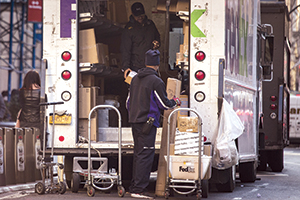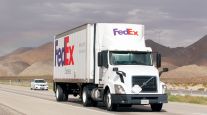FedEx Second Quarter Net Income Rises on Gains at Express, Ground Units

Continued profit improvement at the Express and Ground units helped FedEx Corp. raise overall net income in its fiscal second quarter by 4% to $691 million, or $2.44 per share.
The ongoing cost-reduction program at FedEx Express produced 26% higher profit, before interest, of $622 million in the period ended Nov. 30, despite a 6% drop in revenue to $6.58 billion. At Ground, profit on that basis improved 13% to $526 million due to higher volume and rates, as revenue rose 32% to $4.05 billion.
FedEx Freight’s profitability deteriorated 10% to $101 million, as revenue fell 2% to $1.55 billion and costs such as wages increased.
Companywide revenue increased 4% to $12.45 billion for the period ended Nov. 30.
“It appears FedEx has been flexible enough so far to handle the surge in e-commerce packages, but clearly the company has been putting some investment back into the network to support current and future growth,” said a report from Nate Brochmann, an analyst at William Blair & Co. “Industrial production and global trade continue to be weak, but strong e-commerce and business-to-consumer [shipping] trends appear to have overshadowed those pockets of softness in the quarter.”
The results were achieved against a backdrop of a lackluster U.S. and global economy that hurt manufacturing demand and the surging e-commerce trend that is transforming Ground unit operations.
“A record number of holiday shipments — fueled by the steady rise of e-commerce — are flowing through the FedEx global networks,” CEO Frederick Smith said in a statement. “FedEx Corp. posted solid earnings despite continued weakness in industrial production and global trade, and we are making impressive progress toward our goals.”
Excluding gains and charges, earnings increased 19% to $729 million, or $2.58 per share.
Memphis, Tennessee-based FedEx, which is No. 2 on the Transport Topics Top 100 list of the largest for-hire carriers in the United States and Canada, on Dec. 16 maintained its $10.40 per share to $10.90 per share yearly earnings forecast.
“We expect our solid earnings growth to continue in the second half of our fiscal year,” Chief Financial Officer Alan Graf said, helped by e-commerce.
Smith noted that while e-commerce has been beneficial, it has presented challenges in the form of shipments that are oversize and poorly packaged, taking up too much space in trailers. That trend, affecting as much as 10% of packages, forced FedEx to impose surcharges on outsize shipments that aren’t suited to package processing equipment.
The FedEx founder observed that the ability to use 33-foot trailers “would have mitigated a lot of the inefficient cube development we have been talking about.”
Smith said FedEx was “extremely disappointed” that recent federal legislation barred the use of that equipment, which increases cubic capacity by 18%.
“The forces that opposed it [33-foot trailers] quite frankly weren’t well-informed on the issue,” Smith said.
In addition to surcharges, e-commerce is prompting other changes at the Ground unit.
The company continues to work on integrating home deliveries by Ground drivers and its SmartPost program, which provides delivery through the Postal Service. No timeframe has been outlined for that integration process.
Henry Maier, who heads FedEx Ground, said the company also is testing Monday home delivery of Ground packages to add a sixth service day. Ground packages currently are delivered Tuesday through Saturday.
At Ground, the operating ratio was 87.0, a 2.1 percentage-point deterioration that was attributed to a change in accounting for SmartPost revenue and inclusion of Genco, a logistics company acquired earlier this year. Package volume rose 9%, and revenue per package climbed 10%.
Express’ operating ratio was 90.6, the best in nine years, and 2.4 percentage points better on a year-over-year basis. Package volume rose 1%, but rates per package fell 7% due to fuel surcharge and currency exchange factors.
Freight’s operating ratio of 93.5 was 0.6 percentage point worse than the prior-year period. Graf said the $47 million, or 7%, rise in the unit’s wages and benefits were accompanied by lower than anticipated growth. Shipments rose 1%, reflecting higher economy and lower priority volume. Revenue per 100 pounds of freight fell 2% to $19.93, including fuel surcharges and increased 2% excluding those fees.
FedEx still expects to complete its $4.9 billion acquisition of TNT Express, a Dutch freight and package company, in the first half of 2016.
Graf said integration of TNT “is going to take some time and it is not easy to do.”
FedEx doesn’t expect much financial benefit until the 2018 fiscal year, he said, without gauging the effect on profitability.




